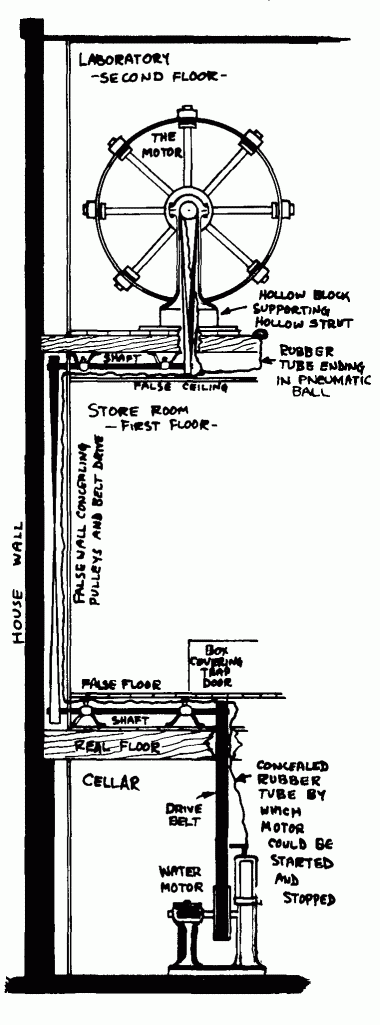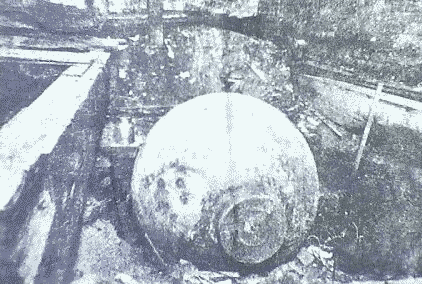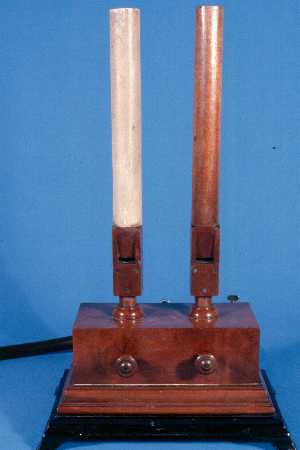







Keely's "Fraud"

Quotes from the Contemporary Press
After Keely died on Nov. 18, 1898, suspicious skeptics and newspaper reporters did a careful examination of his laboratory. Some of Keely's machinery had already been removed by "believers" who hoped they could make it work.
A Boston electrician, Burton Kinraide, removed the engine to his home at Jamaica Plains. Some of the apparatus ended up in England. No one could make it function as it had in Keely's laboratory. The secret was not in the machines; the secret was in the laboratory building itself.
Engineer Alexander Scott and Mrs. Moore's son, Clarence, examined the building, accompanied by press and photographers. False ceilings and floors were ripped up to reveal mechanical belts and linkages to a silent water motor in the basement (two floors below the laboratory). A system of pneumatic switches under the floor boards could be used to turn machinery on and off. A three-ton sphere was found in the basement, apparently a reservoir for compressed air.
The walls, ceilings and even apparently solid beams were found to have hidden pipework. The evidence of fraud on a grand scale was obvious and undeniable.
What's really remarkable is that Mrs. Moore had persuaded a number of apparently respectable scientists to observe Keely's demonstrations, and some of them affirmed that they were impressed, and even convinced that Keely had made revolutionary scientific discoveries. Why were some so easily duped by Keely's obvious (though very elaborate) deceptions, which were correctly guessed by more perceptive and skeptical observers? Of course, it must be stated that Keely never allowed anyone to examine his machines, independently test them, or even look inside of them. Even today, scam artists promoting energy machines can find at least a few degree-holding engineers or physicists willing to declare publicly that they found no fraud or deception in the machines and who are convinced that new scientific principles are at work. So much for "expert witnesses".
Keely had kept his company going for 26 years without ever putting a product on the market, paying a dividend or revealing his secrets. That's his one undisputed accomplishment. He never divulged his secrets with anyone, so far as we know. One close friend reported that he had once asked Keely "John, what do you want for an epitaph?" His answer: "Keely, the greatest humbug of the nineteenth century."

The evidence that this equipment existed is undeniable. The conclusion that Keely used compressed air to operate his machines appeared to be proven and history has left it at that.
But is it true? I do not think so. The evidence speaks against it.
We have detailed and explicit photographs of some of Keel's motors in assembled and disassembled states. There is nothing in his motors for compressed air to act upon.
The very people that cried fraud were at the time in possession of his motors.
It would have been a simple matter to disassemble them and show the driving mechanism (some air turbine or some piston arrangement). Photos of such an arrangement would have convinced the sternest sceptics.
No such proof was forthcoming. It simply did not exist. So is there another reason for the existence of the compressed air equipment and can we after all this time reconstruct what it was used for based on existing evidence alone.
I believe I have found the answer to that puzzle.
I have talked at length about the necessity of bringing about structural changes in the materials of his resonators in order to achieve pure resonant frequencies free from nodal interferences.
Keely tells us that this is achievable through subjecting his resonators to a stream of "pure concordant harmonies", an essential part in his system of "graduation".
This stream had to be kept up for extended periods of time to bring about the re-arrangement, at least weeks, if not months.
So, how did he do it?
Today it would be a simple matter. Connect a series of phase locked loops to an amplifier, and a speaker. Put the speaker into some sort of soundproof box to eliminate rogue frequencies from the environment, mount his resonators to be graduated inside the box and let the thing run for the time required.
But Keely did not have access to that kind of technology.
How then could the same effect be achieved with the technology of the day?
Again we must look to Rudolph Koenig and his scientific apparatus.
Koenig calls his device in his catalogue "Wind Chest"

Koenig's Wind Chest
The way it operates is simple.
On top of a hollow box are mounted one or more organ pipes. The box is connected to an air supply and voila an audio generator capable of generating complex waveforms that will work as long as the air supply is kept up.
Notice the air supply at the back and the organ stops in the front.
Of course you can have as many pipes as you want as long as the wind chest is big enough.
This explains the water motor, the compressed air sphere and the pipes leading into his workshop.
There really was no other way of doing it in Keely's time.
Next Chapter:
KEELY'S USE OF THIRDS
Contact:
Hans von Lieven, copyright
2007

















